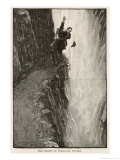Now I am grown up and:
a) I suspect Lewis Caroll was more or less on Alice's side in this question. (after all, Alice's Adventures in Wonderland is, itself, an illustrated book....) and therefore the joke was on me when I thought I was allying myself with the forces of wisdom and maturity.
b) I find I still have a lot of use for books with pictures. Some are breath-taking works of art in their own right, which is why I often find the children's section the most alluring part of the library. (Mind, I tend to use my daughter's baby-pink Junior Reader card when I take them out. I wave it ostentatiously under the librarian's nose as if to say, "Obviously, I'm not borrowing this for myself! I'd use my grown-up, white library card if it was for me! This is for a child!")
Though how anyone could be ashamed of borrowing Paul Gallico's The Snow Goose, illustrated by Angela Burnett, I don't know. I'd been through life without ever reading The Snow Goose until a couple of months ago this edition, on the children's display table in Douglas library, made me do a double-take. I can't imagine it in any other format now. The text would be a bit baggy and untethered on its own, it seems to me. Angela Burnett's wistful illustrations make the book a complete and lovely thing.
I wonder why illustrated fiction is reserved, by and large, for children? (I'm not talking about graphic novels, which have their own kudos, I mean books where pictures serve a written narrative.) Obviously there are sound, practical reasons why children's books are illustrated; it would be difficult (impossible?) to learn to read without pictures there to prompt comprehension, turn a mind-boggling string of words into a story and generally keep things lively. But after childhood? Given that a good picture is a lot more than a mere vocab prompt?
I wonder whether artistic snobbery is part of the answer, i.e. a sense that 'proper art' isn't illustrative? That 'proper art' is its own justification and shouldn't be subordinate to a text? After all, much twentieth century art was the heir of Impressionism, which consciously rejected an (admittedly tired and over-prescriptive) tradition of narrative painting in favour of capturing light, movement and the beauty of the incidental. It's been a while, I know, but out-moded prejudices can linger....
At any rate the Victorians were very keen on marrying words and pictures: the Pre-Raphaelites gorged themselves on Shakespeare, Dante and Malory, while Establishment figures like Lord Leighton and Edward Armitage were reworking stories from the Bible and Greek Mythology. The Victorians also illustrated their books and newspaper serials without worrying that they were doing anything odd or childish - think of Phiz's illustrations for Dickens novels or Sidney Paget's definitive Sherlock Holmes.
 |
| Paget's Holmes teetering over the Reicenbach Falls |
It's partly my new Kindle that's made me think about all this. I was reading a freebie copy of Peter Ibbetson by George Du Maurier: the illustrations weren't there but, oh so tantalisingly, the captions still were, so that the text was interrupted here and there with [Illustration: "Good old Slade!"] or [Illustration: "Ominous birds of yore."] Now that throwaway paperbacks are giving way to electronic books, I wonder whether physical books will tend to be of the carefully-crafted, hard back type that people buy as a luxury? If so, might illustrations come back into vogue? Susannah Clarke's 2004 novel Jonathan Strange & Mr. Norrell with its lovely, smoky drawings by Portia Rosenberg, gave me some hope. But then again, the story is set in the early 1800s, so maybe they were included to give the book a retro feel. I don't want illustrations to be rare, retro novelties I want them (in case you haven't gathered) to be unsurprising and normal. Not universal; just normal.
 |
| An illustration by Portia Rosenberg for Jonathan Strange and Mr. Norrell |
